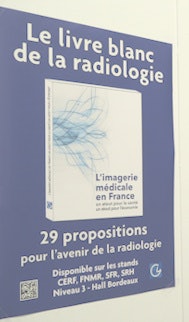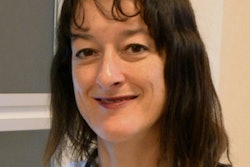
Radiology's in vital need of reform. That's a key conclusion of the latest publication from France's influential Professional Council of Radiology (G4), which was unveiled at the Journées Francophones de Radiologie (JFR) congress and contains 29 proposals to ensure the profession's future is bright.
The White Book (Le Livre Blanc) -- officially called Medical Imaging in France: An asset for health, an asset for the economy -- is the work of 55 authors, including doctors, economists, and patient group representatives who have collaborated on a list of measures crucial for safeguarding the future of French radiology. This in-depth report explores radiology's current role in patient care, and the areas in need of change. It also presents information about patients' view and expectations.
 The White Book was launched at JFR 2016, which ended on Monday. Image by Dr. Robert Lavayssière.
The White Book was launched at JFR 2016, which ended on Monday. Image by Dr. Robert Lavayssière.The book explains that for many years, successive governments have viewed radiology as a cost rather than a source of direct and indirect revenue, one that generates savings in healthcare that more than compensate spending. Fundamental to the detection and follow-up of cancer, and diagnosis of stroke, imaging is also pivotal in prevention and screening programs, the authors note.
Given radiology's central role in healthcare, the profession therefore suggests preservation of access to regional imaging services through the pooling of public and private resources, is indispensible in the face of limited means, tightened budgets, and falling numbers of radiologists: Private clinics, state hospitals, and university centers have recourse to a wide range of imaging techniques for timely accurate diagnoses and the capacity to offer patients the alternative of interventional radiology to surgery.
Furthermore, because technical and technological progress is constant, maintaining a high level of training and ongoing quality assurance is paramount to guarantee the best range of diagnostic and therapeutic techniques to patients, the G4 note.
Here are the 29 proposals:
The range of medical imaging procedures
Proposal 1: Recognize the pivotal place of medical imaging in diagnostics and therapy. Give the specialty the means for carrying out its remit, by maintaining the reimbursement rates for imaging acts.
Proposal 2: Retain regional services that support general practitioners (GPs) and ensure access to first-line radiology as well as breast cancer screening.
Proposal 3: Allow fungibility of budget allocations between specialties and also between hospital and outpatient sectors with part of the savings made in medical imaging allocated to innovative imaging techniques.
Proposal 4: Promote cooperation and partnerships between state hospital radiology services and those of other establishments; universities, non-profit-making private hospitals (Etablissement de santé privé d'intérêt collectif, ESPIC) and profit-making private hospitals, as well as with private radiologists.
Proposal 5: The range of imaging procedures must allow pediatric imaging acts across the whole of France, particularly in emergency situations.
Proposal 6: Create specific MRI and CT tariffs to promote noninvasive acts; specific tariffs for cardiac MRI, coronary CT, and virtual coloscopy, for example.
Interventional radiology
Proposal 7: Develop interventional radiology in line with recommendations in the national Cancer Plan.
Proposal 8: Match regional structuring of interventional radiology with an appreciation in tariffs.
Emergency care
Proposal 9: Improvement in the organization of emergency care necessitates the engagement of supplementary resources, human and material. Cross-sectional imaging is a decision-making tool that is indispensible to emergency medical and surgical teams. Teleradiology, implemented in line with the principles of the general medical council (Conseil National de l'Ordre des Médecins, CNOM) and the G4 charter, may be a facilitating mechanism.
Teleradiology
Proposal 10: Enforce the teleradiology charter created by the G4 and the CNOM to prevent ethical and financial irregularities. Develop teleradiology in line with the G4 recommendations.
Innovation
Proposal 11: Respond to the challenges of new techniques. Prove their medical and economic efficacy; include them in the Good Practice Guidelines for imaging to facilitate their use.
Proposal 12: Promote the use of the most recent technologies in patient care plans by simplifying administrative processes.
Equipment
Proposal 13: Establish a recovery and upgrade plan for French imaging in relation to other European countries, both for access to cross-sectional imaging and for the reimbursement of imaging procedures.
Proposal 14: Establish a development plan for MRI unit numbers and indications to guarantee access to this technique for all, with shorter waiting times.
Training
Proposal 15: Develop public-private cooperation through a policy of support for recently qualified staff that includes the development of work opportunities.
Proposal 16: Promote the development of multicentric imaging research projects in order to anchor research and innovation as part of initial and continuous training.
Proposal 17: Promote collaboration between the radiologist and the team of technicians, through the delegation of duties allowing the latter to improve their profile and further their career.
Proposal 18: Create a complementary option beyond the standard higher diploma model, DES (Diplôme d'Etudes Spéciales) for training in advanced and complex interventional radiology.
Proposal 19: Consolidate the model for continuous training and harmonize it with international continuous training.
Proposal 20: Beyond the initial and continuous training of radiologists, the organization and participation of university radiologists in the training of all doctors and paramedical occupations will ensure quality of care and medical progress.
Quality
Proposal 21: Consider medical imaging in terms of geographical area by pooling human and material resources to promote the quality and the good management of indications across regional hospital groups (Groupements Hospitaliers de Territoires GHT) and shared imaging platforms (SIP). Medical imaging must be reorganized around the patient to improve access to and imaging offers within local services.
Proposal 22: Extend the quality process across all imaging sites, as started by the professional medical imaging community.
Proposal 23: The organization and activity of medical imaging and radiology must be based on procedures in a continuous process of quality assurance, involving the whole team under the leadership of the radiologist.
Proposal 24: Extend the rules relative to all medical imaging devices (2B classification) to all ultrasound equipment so as to ensure effective quality control.
Personal medical record, (dossier medical personnel, DMP)
Proposal 25: Unify the entire imaging record of the patient to avoid redundant exams and improve the medical service provided by the radiologist. Establish PACS between hospitals and private centers while respecting ICT security rules.
Proposal 26: Measure x-ray dose exposure and include the information in a patient's personal medical record.
Institutional
Proposal 27: Recognize regional branches of the G4 as the sole representative of the Regional Health Agencies (Agence Régionale de Santé, ARS) for medical imaging matters.
Proposal 28: Implement a mechanism, led by hospital radiologists, that meets the challenges of hospital radiology, in order to emerge from the serious crisis it is currently in because of limitations that are ignored by authorities.
Proposal 29: Imaging research is indispensable for the advance of medical research in France: The structure and harmonization of imaging research with regard to the FORCE imaging project is a strategic issue. Also, attractiveness of imaging in university hospitals is a future challenge: Confidence in academic directors leading imaging institutes is a key ingredient.
Snapshot of radiologists in France
According to data in the database of health professionals (Répertoire des Professions de Santé, RPPS), France has 8,558 radiologists, 8,377 in mainland France, with a density of 13 radiologists per 100,000 inhabitants across France. These radiologists represent 7.5% of specialists and 66% are male and 34% are female. Also, 74% are in mixed or private practice and 25.8% are in a salaried practice only.
The G4 is composed of four bodies: France's National College of Radiology Teachers, (Collège des Enseignants de Radiologie en France, CERF), the National Union of Private Radiologists, (Fédération nationale des médecins radiologues, FNMR), the French Society of Radiology, (Société Française de Radiologie, SFR), and the Syndicate of Hospital Radiologists (Syndicat des Radiologues Hospitaliers, SRH).



















